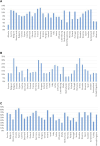Identifying and presenting key country-specific indicators related to medication adherence: a comprehensive study across European countries
- PMID: 39431154
- PMCID: PMC11487323
- DOI: 10.3389/fphar.2024.1390629
Identifying and presenting key country-specific indicators related to medication adherence: a comprehensive study across European countries
Abstract
This study tackles the critical challenge of medication non-adherence in healthcare by pinpointing indicators related to medication adherence (IRMAs) across 39 European countries and Israel. Utilizing a structured expert survey methodology within the European Network to Advance Best Practices and Technology on Medication Adherence (ENABLE; COST Action CA19132), our research identified key country-specific IRMAs and collected data on these indicators to understand the multifaceted nature of medication adherence. The research was conducted in two phases: firstly, defining key IRMAs through a two-round expert survey, and secondly, gathering country-specific data on these IRMAs through literature reviews and additional expert surveys. The study revealed a diverse range of 26 top-ranked IRMAs, including six related to country characteristics, four to social/economic factors, three each to therapy-related and patient-related factors, one to condition-related factors, and nine to healthcare system-related factors. The availability of country-specific data on these IRMAs varied among the countries, highlighting the need for more comprehensive data collection and research. The findings from this study not only underscore the complexity of predicting medication adherence but also lay the groundwork for developing targeted, country-specific interventions to improve adherence. Moreover, this research offers valuable insights for policymakers, highlighting the importance of understanding the multifaceted nature of medication adherence and offering a valuable resource in formulating targeted health policies to enhance health outcomes and reduce the economic burden associated with medication non-adherence.
Keywords: Europe; health policy; indicator; medication adherence; persistence.
Copyright © 2024 Ágh, Garuolienė, Granas, Gregório, Aksoy, Khanyk, Ortner Hadžiabdić, Kardas and European Network to Advance Best Practices and Technology on Medication Adherence (ENABLE) Collaborators.
Conflict of interest statement
The authors declare that the research was conducted in the absence of any commercial or financial relationships that could be construed as a potential conflict of interest. The author(s) declared that they were an editorial board member of Frontiers, at the time of submission. This had no impact on the peer review process and the final decision.
Figures








References
-
- Ágh T., van Boven J. F., Wettermark B., Menditto E., Pinnock H., Tsiligianni I., et al. (2021). A cross-sectional survey on medication management practices for noncommunicable diseases in Europe during the second wave of the COVID-19 pandemic. Front. Pharmacol. 12, 685696. 10.3389/fphar.2021.685696 - DOI - PMC - PubMed
LinkOut - more resources
Full Text Sources

